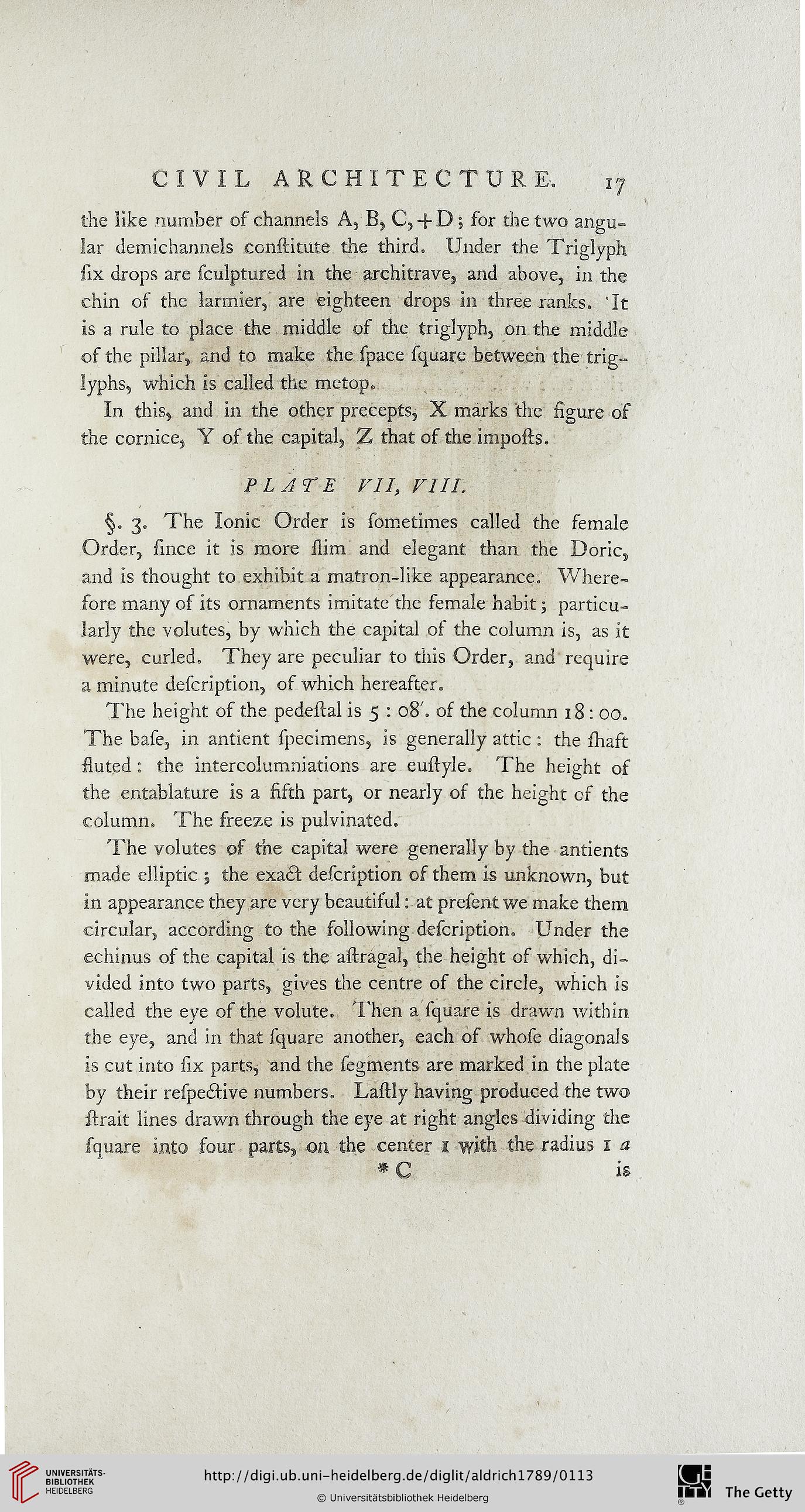CIVIL ARCHITECTURE,
J7
the like number of channels A, B, C, + D ; for the two angu-
lar demicharmels constitute the third. Under the Triglyph
six drops are sculptured in the architrave, and above, in the
chin of the larmier, are eighteen drops in three ranks. It
is a rule to place the middle of the triglyph, on the middle
of the pillar, and to make the space square between the trig-
lyphs, which is called the metop.
In this, and in the other precepts, X marks the figure of
the cornice, Y of the capital, Z that of the impofts.
PLATE VII, VIII.
§. 3. The Ionic Order is sometimes called the female
Order, since it is more dim and elegant than the Doric,
and is thought to exhibit a matron-like appearance. Where-
fore many of its ornaments imitate the female habit; particu-
larly the volutes, by which the capital of the column is, as it
were, curled. They are peculiar to this Order, and require
a minute description, of which hereafter.
The height of the pedeital is 5 : o8h of the column 18 : 00.
The base, in antient specimens, is generally attic: the shaft
ssuted : the intercolumniations are eustyle. The height of
the entablature is a fifth part, or nearly os the height cs the
column. The freeze is pulvinated.
The volutes of the capital were generally by the antients
made elliptic ; the exadt description of them is unknown, but
in appearance they are very beautiful: at present we make them
circular, according to the following description. Under the
echinus of the capital is the astragal, the height of which, di-
vided into two parts, gives the centre of the circle, which is
called the eye of the volute. Then a square is drawn within
the eye, and in that square another, each of whose diagonals
is cut into six parts, and the segments are marked in the plate
by their respedtive numbers. Lastly having produced the two
strait lines drawn through the eye at right angles dividing the
square into four parts, on the center 1 with the radius 1 a
* C is
J7
the like number of channels A, B, C, + D ; for the two angu-
lar demicharmels constitute the third. Under the Triglyph
six drops are sculptured in the architrave, and above, in the
chin of the larmier, are eighteen drops in three ranks. It
is a rule to place the middle of the triglyph, on the middle
of the pillar, and to make the space square between the trig-
lyphs, which is called the metop.
In this, and in the other precepts, X marks the figure of
the cornice, Y of the capital, Z that of the impofts.
PLATE VII, VIII.
§. 3. The Ionic Order is sometimes called the female
Order, since it is more dim and elegant than the Doric,
and is thought to exhibit a matron-like appearance. Where-
fore many of its ornaments imitate the female habit; particu-
larly the volutes, by which the capital of the column is, as it
were, curled. They are peculiar to this Order, and require
a minute description, of which hereafter.
The height of the pedeital is 5 : o8h of the column 18 : 00.
The base, in antient specimens, is generally attic: the shaft
ssuted : the intercolumniations are eustyle. The height of
the entablature is a fifth part, or nearly os the height cs the
column. The freeze is pulvinated.
The volutes of the capital were generally by the antients
made elliptic ; the exadt description of them is unknown, but
in appearance they are very beautiful: at present we make them
circular, according to the following description. Under the
echinus of the capital is the astragal, the height of which, di-
vided into two parts, gives the centre of the circle, which is
called the eye of the volute. Then a square is drawn within
the eye, and in that square another, each of whose diagonals
is cut into six parts, and the segments are marked in the plate
by their respedtive numbers. Lastly having produced the two
strait lines drawn through the eye at right angles dividing the
square into four parts, on the center 1 with the radius 1 a
* C is





